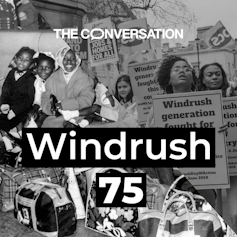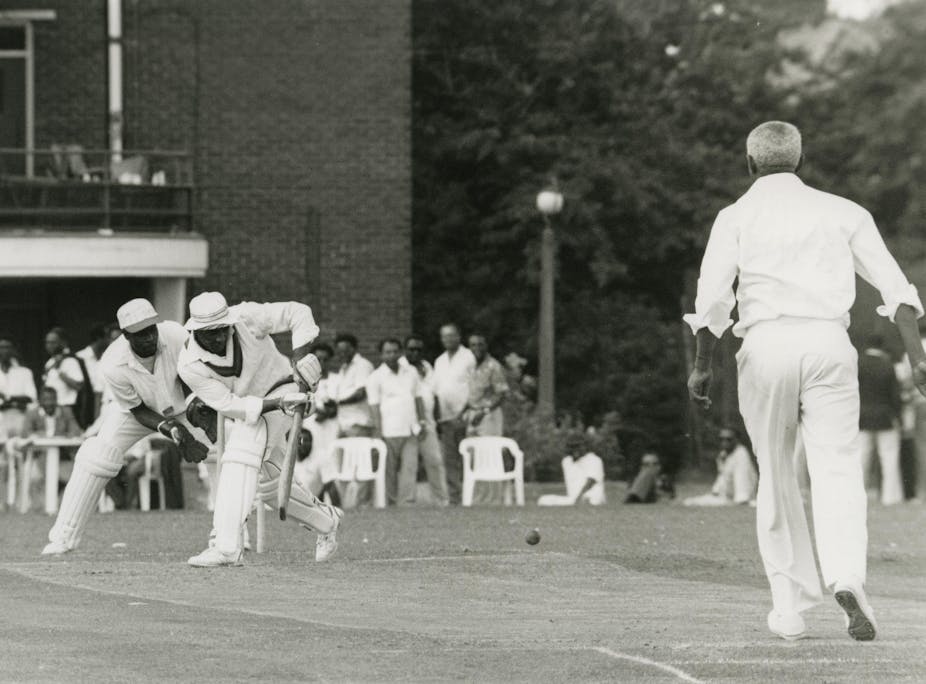Cricket was played extensively in Britain in the 1950s, in towns, villages and cities, both in workplaces and as a social activity. And the sport had also become a ubiquitous cultural pastime in the English-speaking Caribbean.
Indeed, cricket was a key part of Britain’s cultural imperialism, with the game helping to convey ideas about social order – in the colonial Caribbean, cricket clubs were segregated on the basis both of class and “race”. An emphasis on respecting the rules, “fair play” and sporting behaviour all enhanced this sense of white English prestige.
After the second world war, racism forced many new Windrush arrivals – predominantly black Caribbean men looking for employment in manual jobs – to set up their own cricket clubs. One such club is the still-active Carnegie CC, created in 1955 to cater for Caribbean cricketers in and around the Brixton area.

This article is part of our Windrush 75 series, which marks the 75th anniversary of the HMT Empire Windrush arriving in Britain. The stories in this series explore the history and impact of the hundreds of passengers who disembarked to help rebuild after the second world war.
For the Windrush generation, the sport held a particular importance, as my forthcoming book, Windrush Cricket: Caribbean Migration and The Remaking of Post-War England documents. Speaking of cricket in his 1963 memoir Beyond a Boundary, the great Trinidadian writer C.L.R. James claimed that:
There is a whole generation of us, and perhaps two generations, who have been formed by it not only in social attitudes but in our most intimate personal lives, in fact there more than anywhere else.
Despite widespread racism, some Caribbean cricket celebrities were feted by and ultimately found favour with the political establishment. Learie Constantine, for example, became the first black person to sit in the House of Lords in 1969.
Cricketers such as Bertie Clarke, who had played for the West Indies before the war, were integral to glamorous social networks of cricket at the BBC. There, he worked with Una Marson (the radio host and first black woman hired by the BBC) and other new arrivals from the Caribbean on the London Calling radio programme.
By the late 1960s and into the 1970s, there was a rich ecosystem of Caribbean cricket across Britain. Black cricket clubs were widely formed across English cities, starting with Leeds Caribbean (set up in 1948) and swiftly followed by others such as Sheffield Caribbeans, Bristol West Indians and the West Indian Cricket and Sports Club in Manchester.
The clubs and competitions were created by black people themselves, and were a significant bridge between England and “home” in the Caribbean – making cricket an important part of the black Atlantic cultural exchange.
London Transport and cricket
London Transport was a major employer in post-war London, and often emphasised sport and recreation facilities in its recruitment materials. Pamphlets circulated in Barbados informed prospective applicants that, alongside their day jobs on the buses and London Underground, migrant workers would have ample opportunity to play cricket in the capital. By the later 1950s, London Transport had become a big focus for the development of Caribbean cricket in England.

Some of those who arrived saw themselves as temporary visitors, yet travelled back to the Caribbean to play cricket as Londoners. One example is the highly successful Central Road Services (CRS) team, named after a bus garage in south London.
According to Chris Hope, a bus conductor recruited in Barbados:
Most Barbadians were into cricket and Central Road Services cricket team had three or four venues such as Langley Park and Osterley. That’s how we passed our time … The Caribbean islanders used to mix and you were glad to see other black people, to be honest.
In 1975, the CRS team jetted back to Barbados for a cricket tour in an example of the trajectories of migration and return which created layers of identity and belonging for this generation. For many, the idea of home would shift according to context, and cricket could provide a cultural and social link between their two worlds.
Lorenzo Daniels, another bus conductor recruited in Barbados, recalled:
I came over so young and settled down here. I made this my life. This is my home. Barbados is the place where I was born.
Through self-organisation and sheer hard work, some of them, such as Devon Malcolm, Phillip DeFreitas and David Lawrence, rose to represent the England national cricket team. However, their successes frequently provoked a racist backlash, which pointed to deep faultlines opening up in terms of what it meant to be English in a postcolonial world.
Other Windrush cricket-lovers worked at the community level, providing opportunities for young people and spaces for black Caribbean people across generations to interact with each other, in ways that paralleled and intersected with the church and social clubs.
Part of a story of black British history that goes far beyond protest, policing and “resistance”, this remarkable generation of Windrush cricketers were pioneers of community building in England. In so doing, they helped transform what it means to be British.

You can download the e-book here. Thank you for your interest.

